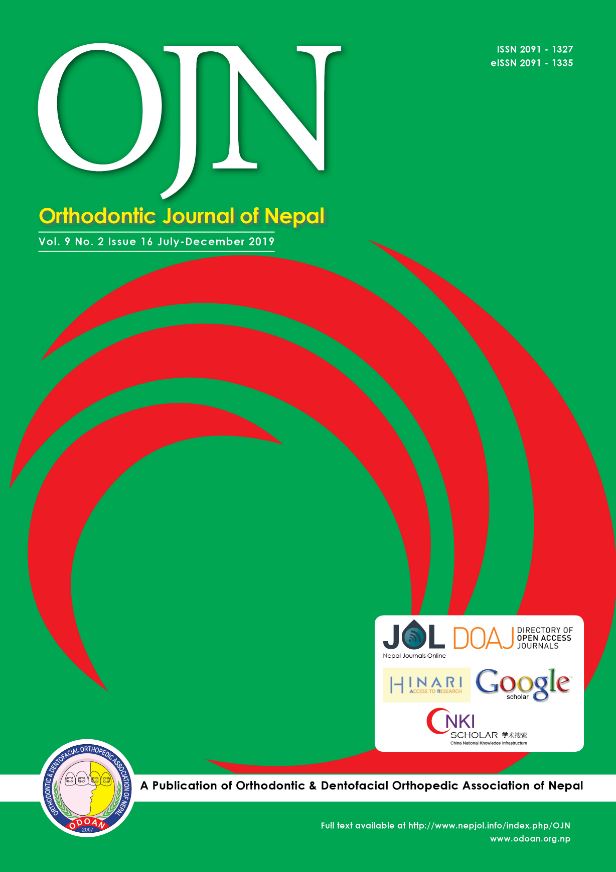Evaluation of Antibacterial Effect of Silver Nanoparticle Coated Stainless Steel Band Material – An In vitro Study
DOI:
https://doi.org/10.3126/ojn.v9i2.28404Keywords:
Band material, Decalcification, Sliver nanoparticles, Antibacterial effectAbstract
Correction: On 23rd April 2020, corrections were made to page 16:
The caption of Figure 6 (p.16) was changed FROM Figure 4: Petridishes showing Lactobacillus colonies of control samples at (a) 24 hours, (b) 48 hours and (c) 1 week TO Figure 6: Petridishes showing streptococcus mutans colonies of control group at (a) 24 hours, (b) 48 hours and (c) 1 week.
The caption of Figure 7 (p.16) was changed FROM Figure 5: Petridishes showing Lactobacillus colonies of test samples at (a) 24 hours, (b) 48 hours and (c) 1 week TO Figure 7: Petridishes showing Streptococcus mutans colonies of test samples at (a) 24 hours (b) 48 hours and (c) 1 week.
Abstract
Introduction: Decalcification, caries, inflammatory periodontal disease are the most common iatrogenic effects of orthodontic treatment because of failure to maintain proper oral hygiene. Although various methods have been tried to minimize the incidence of white spot lesions, none of them proved to be effective. The purpose of this study was to develop a hard coating of silver nanoparticles on stainless steel band material and to evaluate the antibacterial efficacy against most common cariogenic pathogens.
Materials & Method: Stainless steel band material was cut into 45 pieces of about 0.5 x 1 cm in dimension, of these 25 band material strips were coated with silver nanoparticles using thermal evaporation technology in a Vacuum coating unit (Indovision, India) at a vacuum of 4.5 ×10−5 millibar at 961°C for 5 minutes and remaining strips served as control. Scanning electron microscopy (SEM) study of coated band material showed a uniform deposition of silver nanoparticles of about 18.63 percent by weight. Five coated and five uncoated band material strips were utilized for each test to evaluate the antibacterial effect of the coated band material against Streptococcus mutans, Lactobacillus acidophilus using zone of inhibition and direct contact test. In zone of inhibition test, the bacterial growth inhibition zone was measured after a period of 24-48 hours, where as in direct contact test, the number of bacterial colonies were counted after 24 hours, 48 hours and 1 week. Five coated band materials were immersed separately in a container having 5 ml of artificial saliva and the amount of silver nanoparticles released from coated samples was evaluated after 24 hrs, 48 hrs, and 1 week using atomic absorption spectrophotometer.
Result: A stable uniform coating of silver nanoparticles on the band material was obtained by physical vapor deposition. The coated band material showed a potent antibacterial activity against L.acidophilus and S.mutans. The maximum amount of silver nanoparticles released from the silver nanoparticle coated band material was 0.0236 ± 0.0067 ppm, which is below the maximum permissible level set by WHO [0.1 mg /l], proving it as biocompatible.
Conclusion: Silver nanoparticle coating on orthodontic band surfaces can provide suitable antimicrobial activity during active orthodontic treatment.
Downloads
Downloads
Published
How to Cite
Issue
Section
License
Copyright © held by Orthodontic & Dentofacial Orthopedic Association of Nepal
- Copyright on any research article is transferred in full to the Orthodontic & Dentofacial Orthopedic Association of Nepal upon publication in the journal. The copyright transfer includes the right to reproduce and distribute the article in any form of reproduction (printing, electronic media or any other form).
- Articles in the Orthodontic Journal of Nepal are Open Access articles published under the Creative Commons CC BY License (https://creativecommons.org/licenses/by/4.0/)
- This license permits use, distribution and reproduction in any medium, provided the original work is properly cited.




